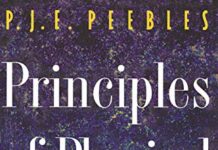
Ebook Info
- Published: 2020
- Number of pages: 444 pages
- Format: PDF
- File Size: 4.53 MB
- Authors: P. J. E. Peebles
Description
The classic textbook on quantum mechanics from Nobel Prize–winning physicist P. J. E. PeeblesThis book explains the often counterintuitive physics of quantum mechanics, unlocking this key area of physics for students by enabling them to work through detailed applications of general concepts and ideas. P. J. E. Peebles states general principles first in terms of wave mechanics and then in the standard abstract linear space formalism. He offers a detailed discussion of measurement theory—an essential feature of quantum mechanics—and emphasizes the art of numerical estimates. Along the way, Peebles provides a wealth of physical examples together with numerous problems, some easy, some challenging, but all of them selected because they are physically interesting. Quantum Mechanics is an essential resource for advanced undergraduates and beginning graduate students in physics.
User’s Reviews
Reviews from Amazon users which were colected at the time this book was published on the website:
⭐Nice review of the basics, including modern developments like Bell’s Theorem, and the Aharonov-Bohm effect. There are many examples of what the author calls “grown up” calculations, and relatively little discussion of abstract theory.
⭐James Peebles: “My hope is that this book will find a niche between introductory surveys and the standard treatises.” (preface). An interesting undergraduate exposition which emphasizes ‘the art of numerical estimates’ allowing for discursiveness. An unusually complete expose of Measurement Theory, along with a beautiful exposition of electromagnetic gauge invariance (for the later, see pages 154-159). For whom is this textbook written? Senior undergraduates and beginning graduates. Advanced methods not a prerequisite: for instance, the slick derivation of Hamiltonian in Polar Coordinates is delightful (page 141), as is the lucid discussion of Dirac Equation (page 406). Dirac-Delta and Fourier analysis being briefly surveyed (page 60). Algebraic methods utilized for solution of simple harmonic oscillator and spin angular momentum. Mathematical derivations are clear, not ponderous. Introduced: bras, kets, operators, eigenvalues, culminating in a summary of “axioms” of Quantum Mechanics (page 188) a recapitulation of the summary which had been accomplished in terms of wave functions earlier in the text (page 104). You really get it twice: wave functions, then state vectors. The term Hilbert space is avoided, also, no path integrals (consult Shankar). I quote from our esteemed author:(1) “The search for variations on the standard theory will continue to be… What does the state vector really mean ? (page 257).(2) “The state of a physical system is represented by a wave function, and each measurable attribute of the system is represented by a linear self-adjoint operator in the space of functions.” (page 114).(3) “One can not really imagine that a point spins.” (page 198).(4) “It would be illogical, even ungrateful, to fault quantum physics for such bizarre predictions, because to the accuracy of available experimental tests the predictions agree with what is observed.” (page 256, the conclusion to the chapter of measurement theory). A few outstanding pedagogic features include:(1) Interweaving the pseudo-historical discussion with modern formalism (especially the first chapter),(2) Excellent problem sets: Chapter two, problems 22, 23, 24– carrying through simple harmonic oscillators, coherent states and squeezed states. Chapter six, problem 5: bound states of Bottomonium quark system. (That is, multi-step problem sets). Outstanding applications of formalism: spin one-half, hyperfine structure, induced transitions, atomic and molecular structure.(3) The final, brief, chapter–Dirac equation– is enunciated from quite an elementary vantage. The text is considerably more verbose than others and reading all of textual material is mandatory. One can not help but compare to verbosity as found in the text of David Bohm (In fact, comparison with it is suggested). However, with Peebles, contact with experimental numbers is always front and center. For instance, the exercises in the chapter of atomic and molecular structure ask for numerical estimates of: zero-point energy of the protons, the binding energy in the ground state, the energy difference between the first rotationally excited state and the ground state– as it pertains to the Hydrogen molecule (page 357). This is a rather distinctive offering in a crowded market. One size does not fit all. (In fact, David Bohm’s discussion of Probability, his chapter four, is difficult to surpass.). While not to everyone’s liking–and, what book is ?– those who choose to peruse its contents will be richly rewarded.A fine contribution to the textbook literature.
Keywords
Free Download Quantum Mechanics in PDF format
Quantum Mechanics PDF Free Download
Download Quantum Mechanics 2020 PDF Free
Quantum Mechanics 2020 PDF Free Download
Download Quantum Mechanics PDF
Free Download Ebook Quantum Mechanics

